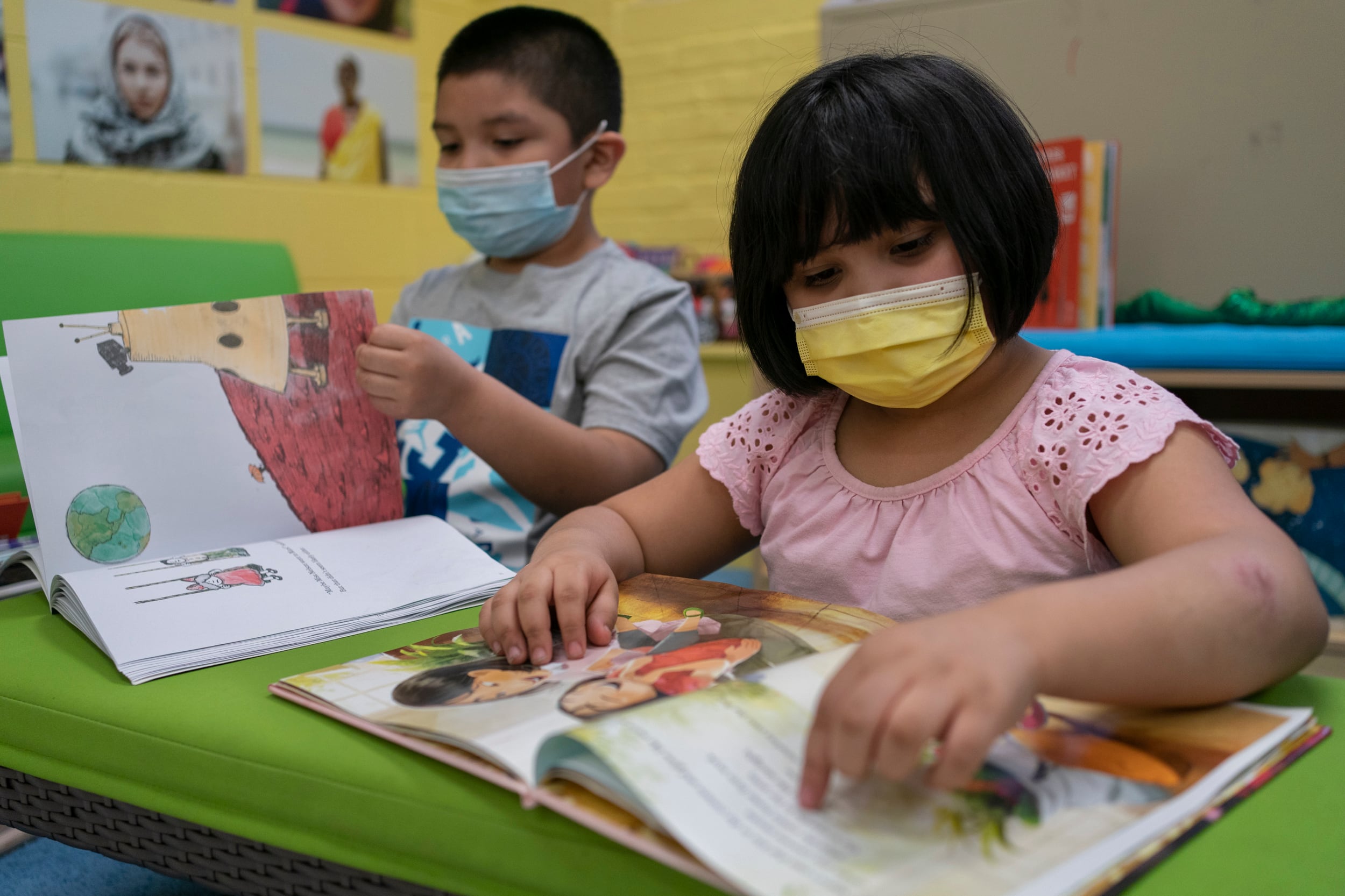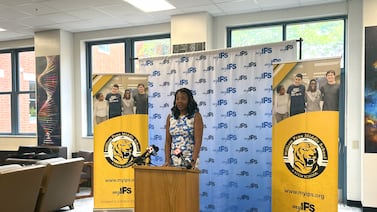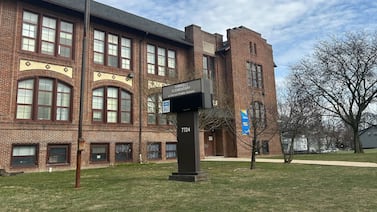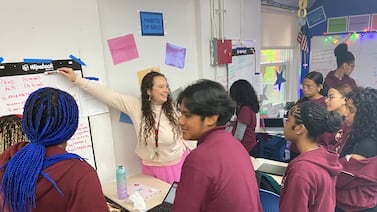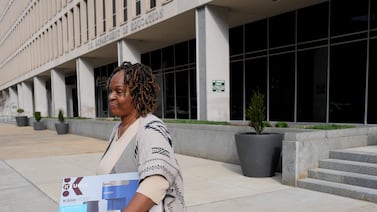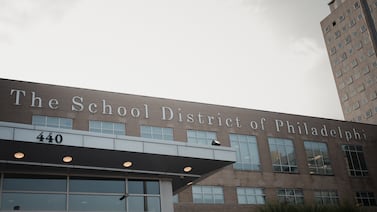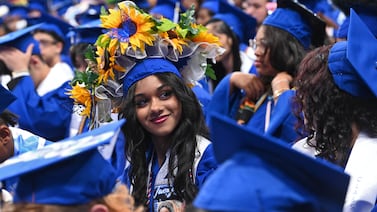In 2022-23 school budgets across Chicago, pandemic-era enrollment losses are colliding with the urgent push to recover from the outbreak’s academic and mental health damage.
In Little Village on the city’s Southwest Side, Zapata Elementary will lose more than $894,000, or about 13% of its budget, next fall — a cut that could claim eight teaching positions and a preschool classroom. Cardenas is looking at $605,000 less, or a 6% reduction, and the resulting loss of four classroom teachers and a support staff member.
The cuts come on the heels of a steep enrollment dip: Little Village’s 14 elementary schools lost almost a fifth of their students during the pandemic, which accelerated a pre-COVID trend of shrinking Latino majority elementary schools throughout the city. Because fewer students are enrolled, the neighborhood’s campuses will actually get an average of $2,600 more per student next fall than they did the year the pandemic hit — despite getting less money overall.
Little Village is also one of the neighborhoods where COVID took the heaviest health and economic toll — and the district is slashing budgets as campuses try to bounce back from that profound disruption. The cuts also come as the district acknowledged spending just 6% of its $1.8 billion in American Rescue Plan dollars, the latest and largest infusion in federal pandemic recovery cash.
Chicago largely shielded schools from the financial fallout of declining enrollment for the last two years, but this fall, 40% of the district’s campuses will see leaner budgets. The district’s principals group says the rising cost of employee salaries and benefits could mean even campuses where budgets stayed relatively flat might need to trim to balance them.
District leaders say that declining enrollment has left some campuses with too many staff members for the size of their student bodies, stressing most schools got a funding boost even after the loss of 25,000 students districtwide during the pandemic. They note that additional help for schools will come from centralized funds for after-school and summer programs, professional development, and more — funds that some school leaders such as Cardenas principal Jeremy Feiwell say will power key staff and programs.
“There is no school where the budget is being adjusted unless the children are just not there — they are literally physically not in the building,” said district CEO Pedro Martinez in an interview.
But advocates fear the cuts could undermine efforts to recover from the pandemic and thrust once-bustling campuses in neighborhoods such as Little Village into a cycle of staff and program cuts that trigger more family defections.
“The school community is losing out,” said Jianan Shi of the parent advocacy group Raise Your Hand, “and that starts a self-fulfilling prophecy. It doesn’t stabilize the community.”
Raise Your Hand launched a social media campaign Wednesday urging parents to email the school board and Mayor Lori Lightfoot in opposition to the budget cuts. With other community groups, it is hosting a Friday press conference at Shields Middle School in Brighton Park. Parents and advocates in Little Village and other neighborhoods are also vowing to press the district to reconsider the cuts ahead of a summer school board vote on the overall district budget.
Some also plan to reach out to state legislators, noting that by the state’s own calculation Chicago schools remain underfunded so the district is trying to divide a pie that’s too small.
Major differences between per-pupil spending at nearby campuses remain
In their school budget announcement last month, district officials touted a $290 million increase in funding for schools. Some of that is going to central funds from which schools will draw to cover various expenses.
Based on data CPS provided last month, district-run campuses will see a net increase of about $60 million, following $225 million more last year, when 95% of schools saw budget hikes. On campuses where budgets will shrink — primarily neighborhood elementary schools — those cuts add up to a total of about $42 million.
Because of enrollment declines and recent budget bumps, only a handful of schools in CPS will see a decrease over pre-pandemic funding on a per student basis. Districtwide across grade levels, schools will receive about $12,800 per student on average, compared with about $12,000 in this school year’s budgets and with roughly $10,050 in 2019-20.
Little Village is a microcosm of the complex picture of the district’s school budgeting. With about $1 million in net cuts across all its campuses, it is second only to Avondale in total reductions, and followed closely by North Lawndale and Garfield Park, two other neighborhoods hard hit by the pandemic.
Elementary schools in Little Village will receive roughly $11,730 per student on average next fall. That’s an increase over last year because the schools serve many fewer students, but just slightly below the districtwide average. To local community leaders, that amount does not adequately reflect the neighborhood’s challenges.
A Chalkbeat Chicago analysis also shows dramatic differences in per-pupil funding between nearby schools with similar demographics here and across the city, often skewed by campus size: The 800-pupil Gary Elementary, for instance, will get about $10,400 per student. The 250-pupil Hammond Elementary will receive $15,250.
At a school board meeting after the budgets were announced, Martinez voiced dismay with media coverage that he said focused disproportionately on the cuts. He said it was more notable that at a time when 75% of schools had flat or shrinking enrollment, 60% saw funding increases — in some cases substantial ones.
The district ensured all schools had money to avoid combining students in different grades in the same classroom, Martinez said, noting that the total amount of district-issued grants to soften the impact of enrollment losses is increasing to $50 million, a $14 million hike over last year. The district also earmarked dollars for art instruction, physical education, and at least one intervention specialist on each elementary campus.
“We are setting a new standard for what every school has to have,” Martinez said in an interview with Chalkbeat.
In some cases, such as at Pilsen’s Orozco Academy, Martinez said, schools had money in their budgets for, say, a special education classroom with no students. Contractual salary increases were factored into the budgets, he stressed, and since the district released those budgets, some dollars have been added for academic coaches, high school athletic coordinators, and counselors.
The district said it is also working with some campuses that might need added help to make their staffing work for the number of students.
Troy LaRaviere of the Chicago Principals and Administrators Association, on the other hand, told the board that rising salary and benefit hikes account for as much as a 6% increase in staffing costs at many schools, so even campuses where budgets stayed relatively flat face cost reductions to balance their budgets. He urged board members to talk to principals and refrain from supporting the district’s final budget without more dollars for schools.
In an interview with Chalkbeat, LaRaviere said an analysis by his association suggests that even under a best case scenario in which campus staffing costs go up only 3.5% next school year, 324 schools out of roughly 500 total district campuses are facing a combined “stability shortfall” of more than $100 million.
He said recent investments in school budgets have not made up for leaner staffing on some campuses dating back to the district’s 2013 shift to student-based budgeting, in which enrollment plays a larger role. LaRaviere said he doesn’t fully understand how the district arrived at its proposed school budgets, with examples of schools that gained students but saw cuts and others whose budgets got a boost despite enrollment decreases.
In Little Village, Hammond, with enrollment down more than 18% over last year — the neighborhood’s steepest loss — will get a modest budget bump. Corkery Elementary, a 415-student school that only lost seven students, is facing a 3% budget cut.
“There doesn’t seem to be a rhyme or reason to these cuts,” he said. “They are especially mean and callous when you know the challenges schools are having as they try to help students reacclimate.”
The district should steer a larger portion of its roughly $9 billion budget directly to schools, LaRaviere said. Next year, about $4 billion is going into school budgets or central funds supporting schools, including $838 million for charter schools, according to the district. The rest will cover central administration, capital, debt service, employee pensions, and other expenditures.
LaRaviere and other critics said the district should tap its federal Elementary and Secondary School Emergency Relief, or ESSER, allocation to give schools stability as they navigate the pandemic recovery.
Officials have said that COVID surges, staffing shortages, and other hurdles have crimped spending on academic and mental health interventions through the district’s half-billion dollar Moving Forward Together initiative to just 12% of the two-year program’s budget.
“We have unspent money,” said Shi of Raise Your Hand. “We are in shock that we are going to cut millions of dollars from local schools during a pandemic.”
In Little Village, cuts went deeper than community leaders expected
At Cardenas, Feiwell, the principal, says class sizes in some grades on the 860-student campus will increase somewhat as it loses four of its teachers. But he sought to reassure members of his local school council that the leaner budget will not arrest momentum in Cardenas’ push to recover from the pandemic, with a redoubled focus on basic literacy skills in the early grades and building relationships with middle schoolers.
The school’s budget does not tell the whole story, he told them: The school will get two centrally funded teaching positions, offsetting what would have been a larger loss of staff. Also from central funds, Cardenas will get after-school, technology, and professional development dollars that will give teachers more time to plan jointly. He stressed the school, which lost 113 students last year, won’t cut programs or key support personnel such as its three social workers, made possible in part by an outside partnership.
“Will we lose great teachers? Absolutely,” Feiwell said. “We don’t have the enrollment to support these positions. But everything we have done before will still be in place.”
Alderman Michael Rodriguez, who represents a large swath of Little Village, said he and other community leaders, as well as some principals were bracing for budget cuts.
Little Village along with nearby Pilsen — another traditionally Latino area that grappled with overcrowded schools less than a decade ago — had some of the city’s steepest enrollment losses during the COVID outbreak. During that time, Latino enrollment losses for the first time outpaced Black student departures, which in the years leading up to the outbreak had been much sharper.
The reasons are complex: The population of Little Village has declined overall amid immigration and demographic shifts. The pandemic displaced families, causing some to double up with relatives in other neighborhoods or in the suburbs.
Still, Rodriguez said, “People are in a bit of a shock at how much some of these budget decreases are.”
Overall, elementary schools in the neighborhood will see about $2.7 million in cuts. Several elementary campuses got modest increases, with more substantial hikes for local high schools.
Rodriguez said the budget news comes amid high hopes that schools here might see enrollment rebound in the fall, as COVID fears ease and families become more comfortable sending their children back to school, especially if vaccines become available for those 5 and younger.
At Madero Middle School, principal Hamed Flores told his local school council this week that despite a loss of $134,000 from the school’s budget, the campus will keep all its staff. That involves covering the school’s International Baccalaureate coordinator with money for an academic coach budgeted centrally and tapping dollars for supplies and digital resources.
Still, some on the council said the school needs extra help rather than clinging to the status quo. The 260-student campus serves 44 students with disabilities and 111 English learners, including a growing number of recent arrivals from Central America with intense language and academic needs. It can use more classroom assistants to help them.
“I feel relieved because I’m always worried about cutting staff,” said Gabriela Oria, who serves on both Madero’s and nearby McCormick Elementary’s school councils, after the meeting.
But she said she wants to see more strategic investment to address the heightened social and emotional needs of students and to draw more students to Little Village campuses.
Astrid Suarez, the education director of the Little Village-based nonprofit Enlace Chicago, said she has heard from school administrators who are trying to determine whether these cuts might claim positions in counseling, academic intervention, or special education — positions they got this school year as part of the district’s pandemic recovery efforts.
Schools in the neighborhood, which have experienced historical disinvestment, need stability as they try to bounce back from the pandemic, she said. They are still working to re-engage families and students, particularly high schoolers who took on jobs during the pandemic to help with household budgets.
“Every penny we cut in our schools means losing positions and deepening the inequities in our schools,” she said. “And that’s very troubling.”
Suarez said Enlace and other advocates are hoping to make a case for rolling back some of the reductions before the school board approves its budget.
Across the city, at the 780-student Jamieson Elementary on the Northwest Side, some members of the Local School Council are looking into the implications of voting down a school budget that’s about $342,000 less than last year, or a 4.2% cut. Local councils have to take a vote on the budgets by April 19.
Jen Streicher, who serves on the council, says that after years of prioritizing lower class sizes in the early grades, the cut could mean the loss of three classroom teachers, a special education teacher, and a paraprofessional — and more students per classroom in some grades. The school, where about 70% of students are low-income and a third are learning English, could also lose one of its assistant principals.
“We have been asking, ‘Is there a way for us to take a stronger stance and advocate for more funding?’” Streicher said.
Kristin Blagg, a school finance expert at the nonprofit Urban Institute, said enrollment declines that are colliding with pandemic recovery efforts present a central challenge for urban districts across the country.
Districts need to tread carefully: Some students who sat out the non-mandatory preschool and kindergarten during the pandemic could return to public campuses in the fall — less prepared for school than their peers — leaving districts that trimmed budgets scrambling to adjust.
The $2,750 more per pupil Chicago schools will have next fall compared to 2019-20 is substantial. But schools are trying to address heightened student needs and handle a slew of new responsibilities, such as COVID testing — while inflation rose and compensation costs continued to increase.
“It’s such a push-and-pull tradeoff,” Blagg said. “You want to allocate funds in a way that reflects current enrollment. You also don’t want to pull funds from schools with high needs.”
Mila Koumpilova is Chalkbeat Chicago’s senior reporter covering Chicago Public Schools. Contact Mila at mkoumpilova@chalkbeat.org.

